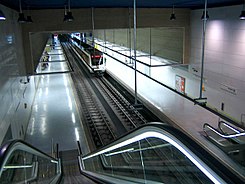Mestalla Stadium
 | |
 | |
| Former names | Estadio Luis Casanova (1969–1994) |
|---|---|
| Location | Avenida Suecia, s/n 46010 -Valencia |
| Coordinates | 39°28′29″N0°21′30″W/ 39.47472°N 0.35833°W |
| Public transit | |
| Capacity | 49,430[1] |
| Field size | 105 m × 68 m (344 ft × 223 ft) |
| Surface | grass/sand |
| Construction | |
| Broke ground | 1923 |
| Opened | 20 May 1923 |
| Renovated | 2005–2019 |
| Expanded | 2007 |
| Construction cost | 316,439.20pts(Purchase of Land) |
| Architect | Francisco Almenar Quinzá |
| Tenants | |
| Valencia CF(1923–present) Spain national football team(selected matches) | |
| Website | |
| valenciacf.com/mestalla | |
Mestalla Stadium(Spanish:Estadio de Mestalla[esˈtaðjoðemesˈtaʎa],Valencian:Estadi de Mestalla[esˈtaðiðemesˈtaʎa]) is afootballstadiuminValencia,Spain. The stadium is the home ofValenciaand has a capacity of 49,430 seats,[2]making it the 8th-largest stadium in Spain, and the largest in theValencian Community.[3]The stadium's name originates from the historic irrigation canal of Mestalla, which was developed and consolidated during the Arab dynasty between the 10th and 11th centuries, and was originally outside the south stand of the stadium where it had to be jumped over in order to get to the ground.[4][5]The North Stand of the stadium is known for its very steep section.[6]
History
[edit]
The Estadio Mestalla was inaugurated with a friendly match on 20 May 1923 betweenValenciaandLevante.[7]The new stadium had a capacity of 17,000 spectators, which was increased to 25,000 four years later. During theCivil War,the Mestalla was used as aconcentration campand storage warehouse.[8]It would only keep its structure, since the rest was an empty plot of land with no terraces and a grandstand damaged during the war.
During the 1950s, the Mestalla was renovated, resulting in a stadium with aseating capacityof 60,000 spectators. It was severely damaged by theflood of October 1957when theTuria Riverbroke its banks. The stadium soon returned to operational use with some more improvements, such as the addition of artificial lighting, and was inaugurated during the 1959Fallasfestivities.
In 1969, the stadium's name was changed to Estadio Luis Casanova, to honour club presidentLuis Casanova Giner.The change lasted for a quarter of a century, when Casanova admitted that he was completely overwhelmed by such an honour and requested in 1994 that the stadium's name be returned to the Mestalla.[9]
1972 saw the inauguration of the club's head office, located in the back of the numbered terraces. It consisted of an office designed in theavant-gardestyle with a trophy hall, which held the flag the club was founded on. The summer of 1973 ushered in another change at the Mestalla, the introduction of goal seats, which meant the elimination of fourteen rows of standing roomterraces.
Future
[edit]A replacement stadium, theNou Mestalla,started construction in 2007, but is yet to be completed.[10]The new stadium is due to have a capacity of 61,500.[11]
Internationals and Cup Finals
[edit]The Mestalla held theSpain national football teamfor the first time in 1925. It was chosen the national team's group venue when Spain staged the1982 World Cup,[12]and at the1992 Summer Olympicsheld inBarcelona,all of Spain's matches up to the final were held at the Mestalla, as they won Gold.[13][14]
The Mestalla has been the setting for important international matches, has held ninecupfinals, has also been a temporary home forLevante,home of theSpain national football teamand exile forCastellónandReal Madridin the European Cup. The Mestalla hosted fourEl Clásicofinals inCopa del ReybetweenBarcelonaandReal Madrid,with1936,1990,2011and2014.In total the stadium hosted ten Copa del Rey finals with the first one played in 1926.[15]
1982 FIFA World Cup
[edit]The stadium was one of the venues of the1982 FIFA World Cup(known as Luis Casanova Stadium at the time of the tournament), and held the following matches:
| Date | Team #1 | Res. | Team #2 | Round | Attendance |
|---|---|---|---|---|---|
| 1982-06-16 | 1–1 | Group 5 (first round) | 49,562 | ||
| 1982-06-20 | 2–1 | 48,000 | |||
| 1982-06-25 | 0–1 | 49,562 |
Transport
[edit]Metro:


Aragó station (Lines 5 and 7)Metrovalencia
Facultats-Manuel Broseta station (Lines 3 and 9) Metrovalencia
Bus lines:
Amadeo of Savoia street in: line 32.
Reyes Prosper street: line 71.
Avenida de Aragón: lines 10, 12, 80, 41 and 79
Avenida Blasco Ibáñez: lines 10, 29, 30, 31, 71, 79, 81, 89 and 90.
References
[edit]- ^"Facilities about Mestalla".www.valenciacf.com.Retrieved31 January2022.
- ^"Facilities about Mestalla".www.valenciacf.com.Retrieved31 January2022.
- ^"Mestalla the pearl of Valencia · Nest Hostels Valencia".Nest Hostels Valencia.1 July 2013.Retrieved14 September2020.
- ^"Ten things you may not know about the Mestalla".La Liga.30 July 2015.Retrieved20 April2022.
- ^Ikemoto; Sakura; Torres Astaburuaga. (2021)."The Influence of Historical Irrigation Canals on Urban Morphology in Valencia, Spain".Land.10(7): 738.doi:10.3390/land10070738.
{{cite journal}}:CS1 maint: multiple names: authors list (link) - ^"Some of the world's scariest places to play or watch football".BBC News.9 November 2018.Retrieved11 November2018.
- ^"mestalla - vcfestadios".Retrieved6 February2020.
- ^"La Liga Stadiums: Valencia's Mestalla Stadium – Beauty of the oldest stadium in Spanish first division".The Indian Express.24 November 2018.Retrieved14 September2020.
- ^"Diez cosas que quizá no sabías de Mestalla".Diez cosas que quizá no sabías de Mestalla.Retrieved6 February2020.
- ^"Calendario y plazos para el derribo de Mestalla y el traslado al Nuevo Estadio".eldesmarque.com.17 April 2019.Retrieved6 February2020.
- ^"Valencia partner with Deloitte for revival of new Mestalla project - SportsPro Media".sportspromedia.com.23 May 2018.Retrieved6 February2020.
- ^"World Cup 1982 finals".Rec.Sport.Soccer Statistics Foundation.Retrieved6 February2020.
- ^"Football Tournament 1992 Olympiad".Rec.Sport.Soccer Statistics Foundation.Retrieved6 February2020.
- ^1992 Summer Olympics official report.Archived28 May 2008 at theWayback MachineVolume 2. pp. 334-6.
- ^"Diez cosas que quizá no sabías de Mestalla".Diez cosas que quizá no sabías de Mestalla.Retrieved17 February2020.
External links
[edit]- Official website

- The new Mestalla
- Estadios de España(in English)


